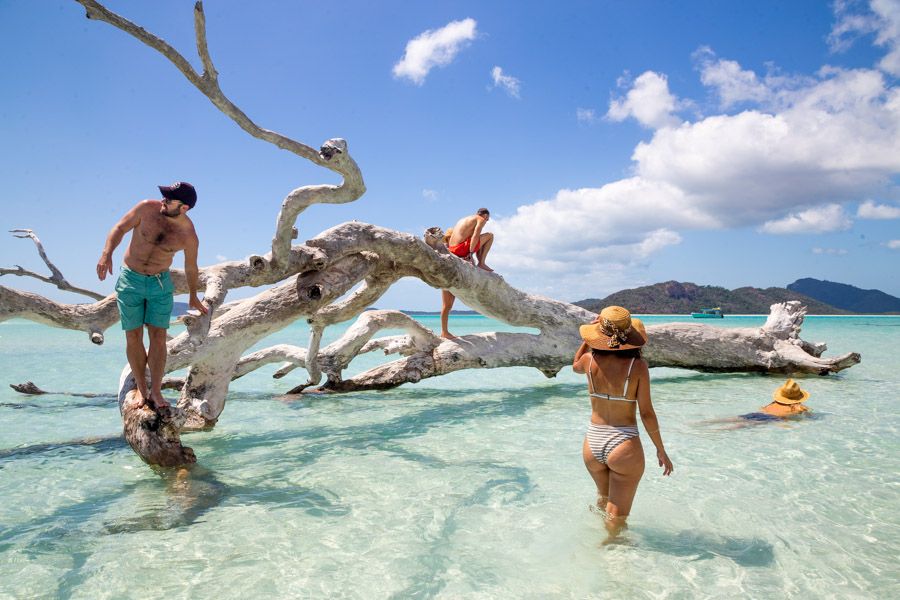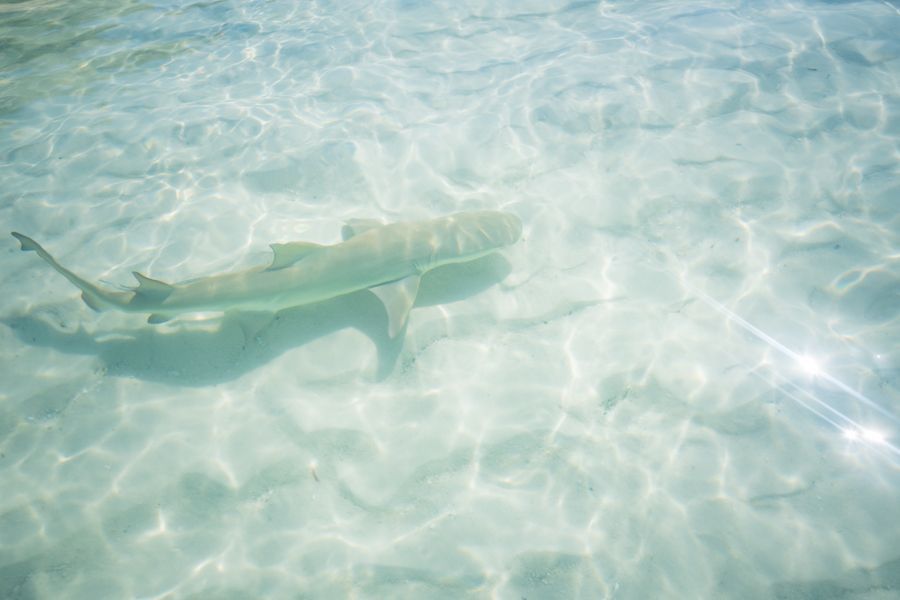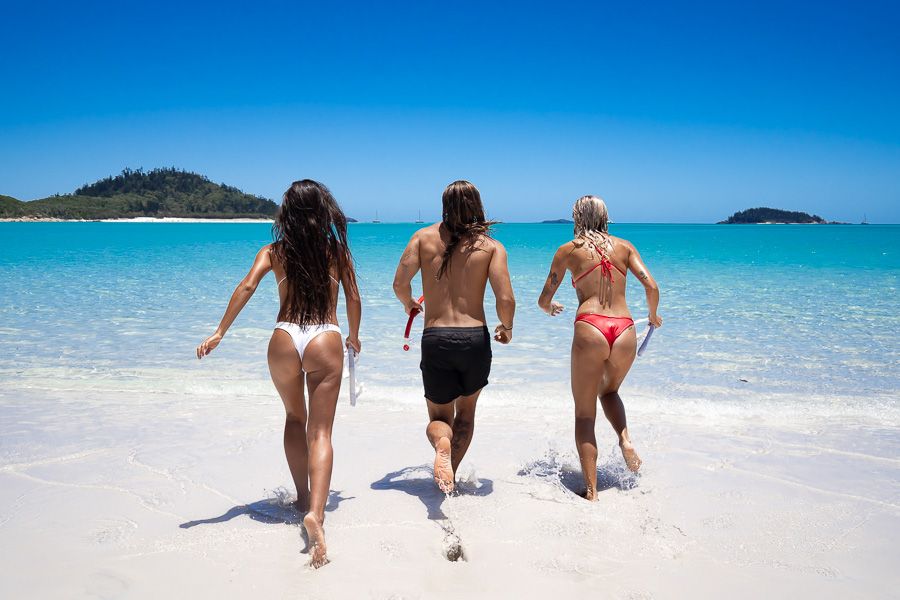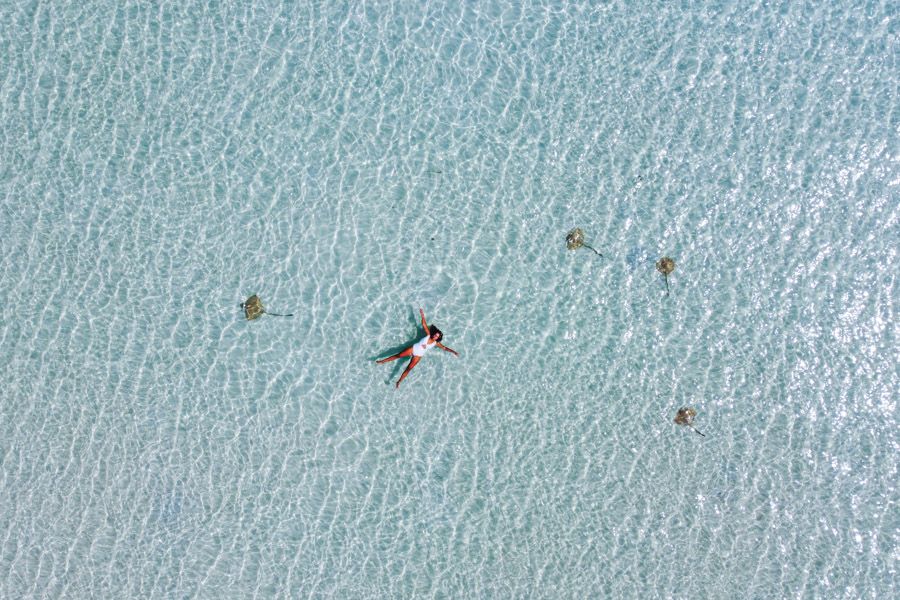Does Whitehaven Beach Have Sharks?

Yes, Whitehaven Beach provides safe and protected nurseries for hatching and young sharks, commonly Lemon Sharks and Blacktip Reef Sharks. Often visitors to Whitehaven Beach will see these young sharks cruising around the shallows or spot them from Hill Inlet Lookout.
Whilst there have been shark attacks in the Whitsundays, these juvenile sharks spotted at Whitehaven Beach are non-aggressive and will often swim away from humans quickly. Larger species of sharks, such as Whitetips, Hammerheads, Grey Whalers and Tiger Sharks can be found on the Great Barrier Reef, however, it is very uncommon to see these species at Whitehaven Beach or popular snorkelling spots around the Whitsunday Islands.
What sharks are found at Whitehaven Beach?
As a protected inlet, you can expect to see a variety of marine life during your Whitehaven Beach visit! From stingrays, sea turtles and small sharks, be sure to keep your eyes peeled for these incredible species.
Lemon Sharks

The large majority of shark sightings at Whitehaven Beach are young Lemon Sharks. A common reef and lagoon dweller in the Whitsundays, females often seek shelter in shallow waters during spring and summer to give birth. Pups (young sharks) remain in these sheltered nurseries for several years, searching for food and remaining largely camouflaged in the sandy waters due to their yellow skin tone.
If you spot a Lemon Shark during your Whitehaven Beach day trip or overnight tour island-hop, be sure to give them plenty of space, as they scare easily and will keep their distance from swimmers. A non-aggressive species, there has never been a Lemon Shark attack in the Whitsundays.
Blacktip Reef Sharks

Whilst sharks aren’t commonly spotted amongst the popular Whitsundays snorkel spots, young Blacktip Reef Sharks can be found amongst inner reefs and Whitehaven Beach shallows. Named after their distinct black tips on their first dorsal fin, they are not considered dangerous to swimmers due to their smaller size and non-aggressive nature.
Similar to the young Lemon Sharks, Blacktip Reef Shark pups enjoy the sheltered waters of Whitehaven Beach and Hill Inlet Lookout. If you are lucky enough to spot these incredible species in the wild, be sure to give them respect and space.
Can I swim at Whitehaven Beach?

Yes, Whitehaven Beach is continuously known as one of Australia’s most pristine beaches! Sheltered from the open ocean by tropical islands, spanning over 7 kilometres in length and boasting year-round water temperature averages of 26 degrees, Whitehaven Beach is the ideal destination for swimmers of all strengths to take a refreshing wade.
Attracting thousands of sun-seeking visitors each year, the biodiverse marine life at Whitehaven Beach is a major highlight, in addition to the 98% pure silica sands and gleaming turquoise waters. During your blissful swims and snorkels be sure to respect the incredible marine life that calls the Whitsundays home, by keeping your distance and looking, but not touching.
Swimming at Whitehaven Beach during Stinger Season
Stinger season in the Whitsundays takes place during the warmer Aussie months, from late October until May. During this time, the Great Barrier Reef waters create ideal conditions for marine stingers to breed, including deadly stingers such as Box Jellyfish and Irukandji.
Whilst encountering or being stung by a harmful marine stinger is a rare occurrence within the Whitsunday Islands, it is crucial that locals and visitors wear a stinger suit during stinger season. Luckily for you, the majority of Whitehaven Beach tours provide a stinger suit for no or little cost. Keeping you protected from stingers and the sun, donning a stinger suit can throw off your holiday style but it’s a simple, effective preventive measure!
Larger sharks found in the Whitsundays

It is unlikely you will encounter a larger shark during your time in the Whitsundays, as larger species such as Hammerheads, Grey Whalers, Leopard and Tiger Sharks are found in deeper Outer Reef waters and no-swim zones such as Cid Harbour. When left alone, these sharks are of minimal threat to humans, however, visitors should respect these powerful species by not swimming in the areas they frequent.
All of the top snorkelling sites around the Whitsunday Islands are considered low-risk shark areas due to their shallow reef nature. However, groups bareboating a vessel shouldn’t enter the water for a swim if they are unsure whether or not the area is safe for swimming.
Shark safety in the Whitsundays
During a Whitsundays tour rest assured that your highly trained skipper and crew will take you to low-risk shark areas in and around the islands. It is extremely unlikely to encounter an aggressive shark whilst adventuring around the inner fringing reefs, as sharks are intelligent creatures who avoid human interaction where possible. Nonetheless, it’s important to remain shark smart and always listen to your crew!
Recommended by the Queensland Government, be sure to remain Sharksmart during your Whitsundays adventures:
- Check and follow the instructions on signs before entering the water. Areas such as Cid Harbour are designated no swimming zones.
- Always swim and snorkel with a buddy.
- Avoid swimming at dawn or dusk as most shark species are more active during these periods.
- Swim in clear waters where you can see your surroundings, away from fishing activity.
- Reduce your risk and avoid schools of bait fish which sharks are likely to feed on.
- Always keeps fish waste and food scraps out of the water where people swim.












